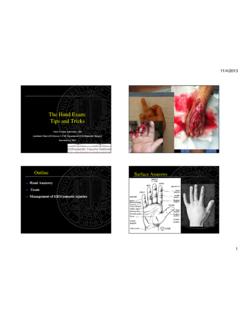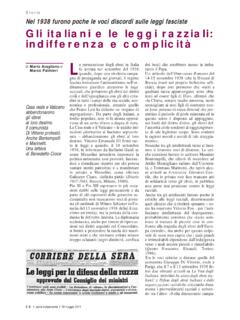Transcription of Hyponatremia and Other Electrolyte Disorders - …
1 Hyponatremia and Other Electrolyte DisordersSharon Anderson, of Nephrology and HypertensionOregon Health & Science UniversityPortland VA Medical CenterOctober 2012 DisclosuresNothing to DiscloseHyponatremia Most common Electrolyte disorder in hospitalized patients Chronic Hyponatremia is common in the elderly: thiazides, CHF, cancer, SIADH (drugs) Consequences: osteoporosis, gait disturbance, fallsSNa = 130 mEq/LSNa = 139 mEq/LRenneboog B, AJM 119:e71,2006 Risk of Inpatient Hyponatremia by AgeBerl T. CJASN, in press (10/04/12)*p < Hyponatremia and MortalityLeung AA, et al. Arch Intern Med (09/10/12) Aim: to determine association between preop Hyponatremia and 30 day mortality Reviewed NSQIP database Compared those with Hyponatremia (< 135 mEq/L) vs.
2 135 144 mEq/L Preop Hyponatremia risk of 30 day mortality, vs. , OR Also CV events, wound infec ons, PNA, LOSP reoperative Hyponatremia and MortalityLeung AA, et al. Arch Intern Med (09/10/12) Hyponatremia is a WATERD isorderAssessment of Hyponatremia Measure serum osmolality Normal: isotonic pseudohyponatremia (hyperlipidemia, hyperproteinemia) Low: true hypotonic Hyponatremia Assess volume status Measure urine sodium and osmolalityDiagnosis of SIADHE llison DH, Berl T. NEJM 356:2064, 2007 Essential Features serum osm < 275 mOsm/kg of water Urinary osm > 100 mg/kg of water while hypotonic Clinical euvolemia Urine Na > 40 mEq/L with normal Na intake Normal thyroid, adrenal fnx No recent diureticsSupplemental Features Plasma uric acid < 4 mg/dl BUN < 10 mg/dl FENa> 1%; FEurea> 55% Failure to correct after NaCl infusion Correction with fluid restriction Abnormal water load test Elevated plasma AVP Related SIADHU pdated from Ellison DH, Berl T.
3 NEJM 356:2064, 2007 Pain meds: opiates, tramadol, NSAIDs Antidepressants: SSRIs, tricylcics Proton pump inhibitors Chemo: vincristine, cyclophosphamide, cisplatin, ifosfamide, imatinib Street drugs: MDMA (ecstasy), nicotine Antiepileptics: carbamezepine Others: ciprofloxacin, amiodarone, ACEI, clofibrate, antipsychotics, of Symptomatic Hyponatremia Hypertonic saline Calculation: mEq needed = x wt (kg) x (desired actual Na) One liter of 3% NaCl = 513 mEq NaCl ml of 3% NaCl needed = (mEq NaCl needed x 1000)/513 Rate of infusion: adjust to Na by 1 vs. Normal Saline? Well, she is pretty hyponatremic.
4 I don t really want to move her to the ICU for hypertonic saline, so let s keep her on the floor and use normal saline. If the urine osm > 300 mOsm/kg, giving normal saline will WORSEN hyponatremiaWhat about Conivaptan? Non selective vasopressin V1a/V2 receptor antagonist Intravenous, ICU only, 4 days max Very effective in raising serum sodium Drug interactions are common OVERSHOOTcan happen easily; monitor serum and urine Na q 2 hoursAsymptomatic Hyponatremia Nearly always chronic Common causes (esp. in the elderly): thiazides, SSRIs, NSAIDs, PNA, subdural hematoma, cancer/chemotherapy, tea and toast diet, idiopathic Hospitalization is usually NOT required Remove offending culprit(s); fluid restrictionAsymptomatic Hyponatremia ALL fluids are mostly water!
5 Fluid restriction + NaCl tabs = oral hypertonic saline Example: 1 gm NaCl tablets 3x/daily Demeclocycline UreaSALTWATER TRIAL: TolvaptanBerl T, et al. JASN 21:705, 2010 Oral Vaptans: Caveats Hospitalization required for initiation; then frequent outpatient monitoring Risk of nephrogenic DI if fluids cannot be readily accessed Cost is prohibitive to many Stop the drug Hyponatremia recurs; not a much in- Too little out- Redistribution from cells extracellular fluidHyperkalemia: Too Much In Fruits and vegetables: not all created equal High K: bananas, oranges, lima beans, celery Low K: tangerines, lettuce, green beans, carrots Dietary consult/handouts = essential!
6 Ask about OTC K supplements (leg cramps) Ask/counsel about salt substitutesSalt Substitutes Be Specific!Ingredients:Potassium Chloride, Fumaric Acid, Tricalcium Phosphate and Monocalcium :Onion, Spices (Black Pepper, Chili Pepper, Parsley, Celery Seed, Basil, Bay, Marjoram, Oregano, Savory .. Hyperkalemia: Too Little Out100 mEq90 mEq10 mEqRenal Potassium ExcretionNaKTubule LumenBloodPrincipal Cell3 Na2 KLow GFRLow urine volumeAmilorideTriamtereneTrimethoprimRe nal Potassium ExcretionNaKTubule LumenBloodPrincipal Cell3 Na2 KDigoxinSpironolactoneACEI/ARBsNSAIDsCyA , FK506 HeparinHeparin induced HyperkalemiaOster JR, et al.)
7 Am J Med 98:575, 1995 Some K in 7% of pa ents, but usually need Other factors for large rise in K Mechanism: inhibition of aldosterone production in adrenal zona glomerulosa, mostly via decrease in Ang II receptor number and affinity Occurs within a few days of therapy; is reversible; is unrelated to anticoagulant effect or route of administration Can occur with low doses [5000 units twice daily] and with low molecular weight heparinsRenal Potassium ExcretionNaKTubule LumenBloodPrincipal Cell3 Na2 KSpironolactoneand Other aldosterone blockersEstimation of Aldo EffectTranstubular potassium gradient (TTKG)TTKG = UK/PKUosm/Posm< 6 = Hypoaldosteronism > 10 = Normal 6 10 = IndeterminateTreatment of Hyperkalemia Hyperkalemia is a medical emergency You can always shove K into the cells FASTER than you can remove it from the body!
8 Kayexalate = too little, too late Don t let a normal EKG lull you into a false sense of securityTreatment of Hyperkalemia: Redistribution Insulin + glucose = best Beta agonists also work (but very high doses are needed; risk of arrhythmias) Bicarbonate is often NOT very effectiveChanges in Plasma K in ESRDA llon M. JASN 6:1134, COURSE (0-60 mins)Change in K (mEq/L)BicarbonateEpinephrineInsulinDial ysisHypokalemia Etiology: Too little in, too much out, or redistribu on from extracellular fluid cells Think about: Na delivery to distal tubule (IVF, diuretics); beta agonists; adrenocortical steroids; aminoglycosides.
9 Amphotericin, cisplatinum Use the TTKG to help with diagnosis< 2 = GI loss> 4 = renal loss, aldoCarroll ME, AFP 67:1959, 2003 Carroll ME, AFP 67:1959, 2003 Metabolic Bone Disease in CKD Treatment of Hyperphosphatemia Calcium carbonate (TUMS) Calcium acetate Sevelamer Lanthanum Treatment of Hyperparathyroidism Vitamin D Calcitriol (and others) CinecalcetMineral Metabolism in CKDO pinionMeta-AnalysisRCTV itamin D/calcium/phos/PTHR estrict dietary phosOral phos bindersVit D or analog supplement Concensus in 2012 Calcium and phosphorus are badPTH is bad (unless too low)Vit D is good (probably?)HypomagnesemiaMoe SM.
10 Prim Care 35:215, 2008 Occurs in 7 12% of hospitalized patients; up to 20% of ICU patients Often associated with Other Electrolyte abnormalities (hypokalemia, Hyponatremia , hypocalcemia, hypophosphatemia) Causes: intake, GI absorp on, GI or renal losses DRUGSR isks of PPI TherapyVakil N. Drugs 72:437, 2012 PPIs are increasing associated with risk of: Pneumonia Osteoporosis and bone fractures Infectious diarrhea, C. diff Interac on with clopidogrel CV events SIADH Acute interstitial nephritis HypomagnesemiaReferences Ellison DH, Berl T. The syndrome of inappropriate antidiuresis. NEJM 256:2064, 2007 Berl T.
















